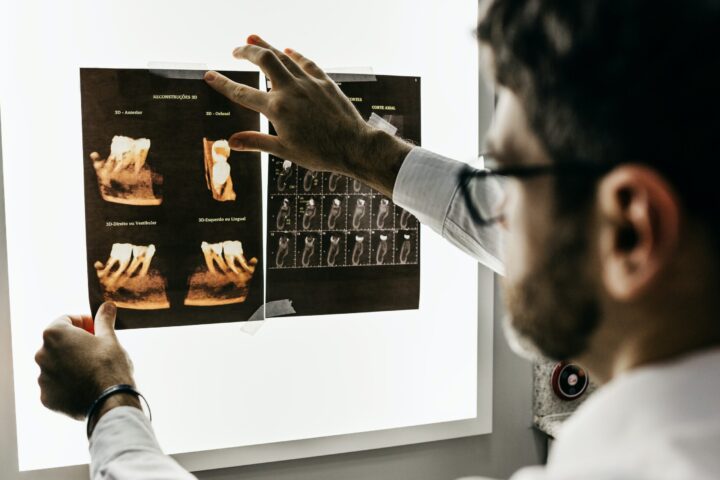AI is disrupting every aspect of healthcare, and dentistry cannot lag behind. The fresher the invention of AI, the more innovations keep happening in dentistry in striving for improved oral health outcomes, creating superior patient experiences, and even smoothing out operations for dental professionals.
AI-driven technologies make their presence felt among diagnostic tools, treatment planning, and even in patient management or new dental materials. In this article, we’ll explore how AI is revolutionizing dentistry, the benefits it offers, and the challenges that come with its adoption.
The Role of AI in Dentistry
AI in Dentistry Implies Embedding: Machine-learning algorithms, neural networks, and other AI capable of interpreting data and making decisions-that is to say, all that human intellect so far has demanded it be done-are now supposed to be embedded in disparate touch points included in dental diagnosis. This helps in personalizing the treatment regime of patients in a more realistic way with outcomes much coveted. Applications of Artificial Intelligence Viewed in Dentistry includes those that
1. AI-powered diagnosis
Diagnostics has been one of the major talking points in relation to the incredible application of AI in dentistry. Diagnosis forms the basis for early treatment. Since diagnosis is conventionally adopted, there are delays and sometimes slight dental diseases are overlooked.
Artificial Intelligence enhances performance because it works by analyzing big volumes of input data. This helps give exact diagnoses, comparing patterns that could simply have been missed through the naked eye of humans.


AI in Radiography: The algorithms in AI study the X-rays, CT scans, and other forms of imaging data available within dentistry. Such systems can detect even caries and periodontal diseases-symptoms from the beginning of oral cancer with far greater precision than one had imagined possible from a traditional system. It may outline some minimal variations in enamel and bone density that might present symptoms of dental caries and dental diseases.
Automation of Dental Image Analysis: Artificial intelligence automates dental image analysis, saving time the dentist would have otherwise used for diagnosis. Therefore, it provides the dentist with more time to attend to patients rather than wasting hours over images. Besides, AI-powered systems can offer immediate real-time image analysis for better insights during a dental examination.
It increases precision in diagnosis, hence increasing speed; this helps the dentist in providing better services and hence identifies problems much earlier before they get serious.
2. Personalized Treatment Planning
AI also plays a very important role in the drafting of personalized treatment planning for dental patients. All patients are not the same in their oral health needs; thus, treatment cannot be provided uniformly to all patients. AI helps the dentist come up with personalized treatment plans suitable for each particular case, need, and preference of every patient.
AI systems can scan the history, genetic factor, lifestyle, and present condition of teeth of the patient, base decisions on insights derived from data, and hence recommend the most suitable mode of treatment. For example, AI will be able to pick whether the patient is a suitable candidate for dental implants or some less invasive treatment is advisable.
Simulation: Most AI systems allow simulation on a number of options and their resultant outcomes by the dentist himself. This, to a large extent, facilitates a better way to visualize the resultant dent from the proposed courses of treatments.
Hence, in this case, the decision about the feasibility of one option out of many becomes way easier to undertake. Example : AI modeling orthodontic treatment would, then, project movement of teeth both without brackets, with braces, and even with transparent plastic aligners.
This would ensure treatment planning was individualized, better results obtained, and increase patient satisfaction. Improvement would be observed in the use of resources in dental care.
3. Improvement in the Patients’ Treatment
Most of the administrative burdens that dentists go through on a routine daily basis relate to maintaining data on appointments, patients, and follow-ups. AI is making such processes in patient management simplified and hence easier on the dentist to keep track of, making sure timely care is ensured for the patients.
Appointment Scheduling: The AI-powered system proceeds with developing appointment schedules in light of availability, the treatment required by the dentist, and scheduling. It leaves no conflict in this scheduling and hence can go for periodic checkup and follow-up cares.
AI can remind the patients about appointments, advisable treatment, and other problem prevention tips over time. It sends these reminders sans any interference, even by a person. The resultant effect reduces no-shows; on occasions, at the same time, this motivates the people to take good oral care best possible in one’s own interest.
Smoothed patient management ensures that down the line of their practice in the art of dentistry, effective communication will ensure positive assurance to stick to the treatment plan.
4. AI in Dental Materials Development
Others are engaged in investigations for the development of new dental materials. Indeed, success of any dental restoration or treatment is promised for durable, compatible, and esthetically acceptable materials. In such processes, AI accelerates through research and development based on the analysis and prognosis of new materials’ properties.
Material Property Prediction: AI will use the molecular structure to predict the mechanical, chemical, and biological properties of the candidate dental material. It will, therefore, enable the researchers to identify the most promising materials even before such materials are actually synthesized, hence accelerating the development process.
AI can also be applied to the already existing dental materials by determining methods of improvement in their performances. For example, AI research into the wear pattern in dental composite provides recommendations for modifications to increase durability.
Restorations are stronger and longer-lasting; more biocompatible, too, because of AI-driven innovation in dental materials. This should finally translate into improved results and more satisfaction for the patients.


Advantages of AI in Dentistry
Along with AI in dentistry, there are many benefits coupled for dentists and patients. Among many, some of the points that might be considered as benefits are listed below. These include but are not limited to:
1. Improved diagnostic precision
AI, therefore, guarantees more assured analysis by this intelligent tool in large data sets for patterns that may not be perceivable by the human eye, hence increased accuracy in diagnosis. This cuts down the chances of misdiagnosis and hence an assurance that the right treatment is meted out at the right time to the patients.
2. Personalized Care
AI will also be of great assistance to dentists in service delivery, ensuring it is personalized. That is, peculiar needs of each patient will be put into consideration; hence, results are better and the patients more satisfied, thus having a positive experience in general.
3. Increased Efficiency
AI automates all the routine work a dentist generally does, such as appointment scheduling, reminders for patients, analysis of data, and so on. That is how it frees up time for the dentist to care for the patients. It amplifies productivity at dental practices and hence one can see more patients in a short period of time.
4. Cost Savings
AI will also be useful in optimizing treatment planning and materials, hence cost-saving for the patient and dental practices. A reduction in superfluous treatments, together with durability in dental restorations, positively influences the possibility of more economic care.
5. Patient Engagement in Treatment
For example, AI-powered simulations of treatment options and personalized reminders keep the patient interested in their care. It improves compliance to treatment and follow-up, hence improved oral health.
Challenges and Considerations
While AI holds much promise in dentistry, many challenges have yet to be met before the promise can be realized.
1. Data Privacy and Security
AI systems need sensitive information related to the medical records, imaging data, and treatment history of the patients. The sensitive use of such data shall, therefore, be done with considerations toward security and shall not compromise trust among patients but must also align with the regulations outlined, such as HIPAA.
Encryption: Whenever the AI system needs to process or store data regarding patients’ information, it needs strong mechanisms for encryption that do not allow unauthorized access.
Wherever possible, anonymization of data in all usages of data in AI applications is important.
Other important considerations that come into play include data privacy and security, and these need to become key enablers in AI adoption for dentistry.
2. Algorithm Bias
AI systems are only as good as the data they were trained on, and since the AI used skewed training data, so will their recommendations. An example would be if an AI, trained using data based on a certain demographic, was asked to make recommendations for treatment on a set of different demographics.
- Training Data: Varied data will train AI systems, thus helping to decrease less bias for different genders, ethnicities, or age groups.
- Monitoring on a Continuing Basis: There needs to be updates regarding the precision of recommendations of an AI system concerning correctness and fairness on a periodic basis.
Knowing this will help make sure all patients receive their fair and correct amount of dental treatment.


3. Integration with Existing Systems
Sometimes, the integration of conventional technologies or dental workflow processes is hard to deal with in integrations with those systems using AI. The AI-enabled diagnostic applications are supposed to be designed for complete integration into the incumbent imaging solutions, and the patient-managing ones shall always remain an integral essential piece with established EHR.
Compatibility The AI will integrate its strength together by complementing other conventional and electronic ways presently existing for envisioning and documentation by way of record booklets.
This thus demands professional user training in the use of such systems, what recommendations of AI are, and how to interpret the same from a clinical point of view in patient care.
Its integration into dentistry will augur well with collaboration between the developers of the technology, dental professionals, and regulators.
Future of AI in Dentistry
With continuous development in the AI technology, its scope of utilization in dentistry will keep on increasing. What to expect:
1. AI-driven robotics in Dentistry
Artificial Intelligence-driven robotics can go the extra mile for dentistry in the near future and work either to assist some procedures themselves. Mundane tasks, like cleaning and drilling, it will do with far greater precision and regularity than it had been done by the human hand.
Surgical Aid: AI-powered robots will assist dentists during difficult procedures by giving them step-by-step, real-time instructions with extreme accuracy. Regular procedures: The robots will be performing regular dental cleaning; this requires less specialized work and would free up time for the dentists to devote themselves to such patients who need specialized work.
In return, AI-driven robotics would mean treatments are homogenous and accurate, leaving little room for errors to occur, hence improvement of results on patients.
2. AI-Powered Teledentistry
- Teledentistry has also been a very attractive avenue for service delivery in dental care.
- Teledentistry can be further enriched with AI by diagnostics and treatment planning remotely.
Remote Diagnostics: These AI diagnosis tools diagnose the forwarded dental images and suggest options for treatment from a distance. In this way, the patient will get the opinion of a specialist without having to actually visit a dental clinic.
Virtual Consultations: Availed by AI in dentistry, all the data about the patient is analyzed by the doctor, and much-valued conclusions are reached even before the consultation has taken place.
Teledentistry through AI assures more access to dental healthcare for those patients that come from very remote and deprived areas.


3. AI in Preventive Dentistry
AI in dentistry can find out the risk factor and thus permits one to prescribe appropriate preventive measures much before the actual problem would strike.
Predictive Analytics: AI will analyze and project dental problems a patient may have in the future, along with the preventive measures that might be required, including fluoride treatments or dietary changes. Preventive Monitoring: Continuous monitoring of oral status for a patient through AI-driven devices can even raise an alarm for problems way before a grave situation arises.
In conclusion, AI preventive dentistry will be extended to healthy patients, saving them medical costs by having the problems noticed well in advance.
Nowadays, AI itself is revolutionizing dentistry with the help of new instrumentation and methods for advanced diagnosis, customized treatment planning, and acceleration of material development. Several challenges include data protection, biased algorithms, and system integration. Yet, the benefits which AI can give to dentistry should not be belittled either.



































Somebody essentially help to make significantly articles Id state This is the first time I frequented your web page and up to now I surprised with the research you made to make this actual post incredible Fantastic job
helloI really like your writing so a lot share we keep up a correspondence extra approximately your post on AOL I need an expert in this house to unravel my problem May be that is you Taking a look ahead to see you
Hi my loved one I wish to say that this post is amazing nice written and include approximately all vital infos Id like to peer more posts like this
Thank you so much
Hi there, i read your blog from time to time and i own a similar one and i was just wondering if you get a lot of spam responses? If so how do you stop it, any plugin or anything you can advise? I get so much lately it’s driving me crazy so any help is very much appreciated.